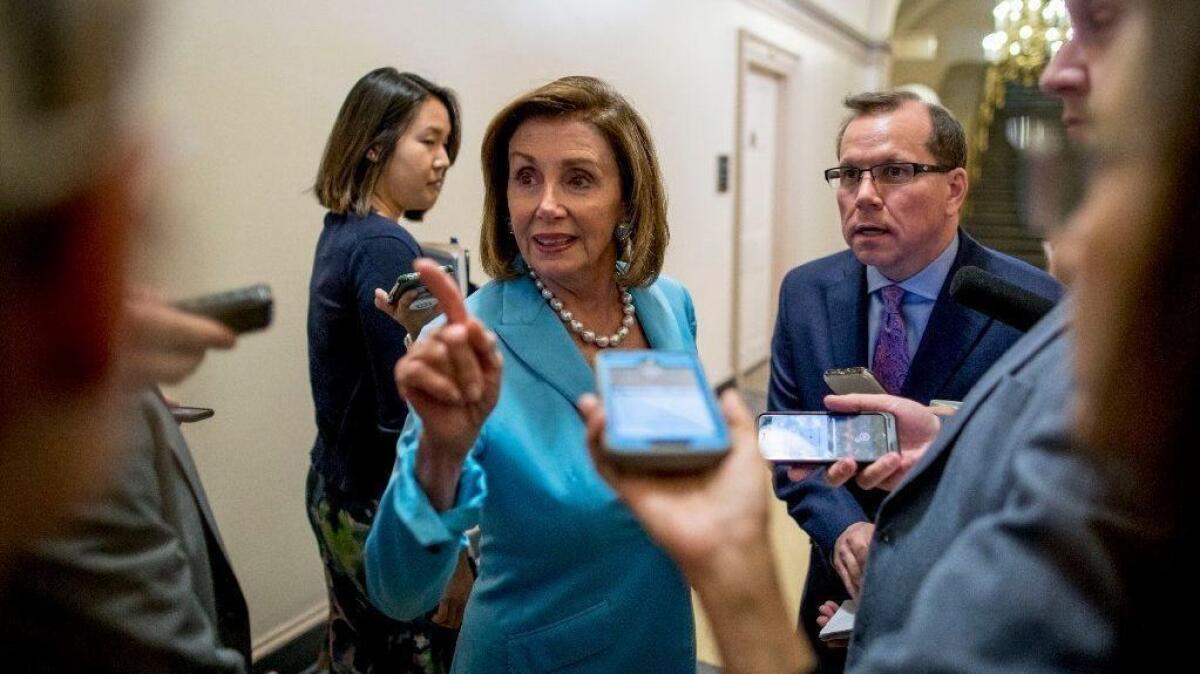Trump announces deal with Democratic and GOP leaders on budget and debt ceiling

- Share via
WASHINGTON — White House officials and congressional leaders reached a deal Monday evening to lift the nation’s debt limit and boost federal spending by about $320 billion over caps set to take effect under a 2011 budget law.
The agreement, first announced by President Trump on Twitter, sets up votes beginning as soon as this week on legislation that will prevent the country from defaulting on its debt — calamitous for the financial markets — and put Washington on pace to spend significantly more over the next two years than fiscal conservatives wanted.
It also removes the possibility of another partisan clash over government spending and the debt limit for the rest of Trump’s term. Those fights instead will confront the next Congress and whoever wins the 2020 presidential election.
Trump in a tweet called the deal a “real compromise in order to give another big victory to our Great Military and Vets!” He said there were no “poison pills” that could trigger political opposition, but the full text of deal has not yet been released.
The plan still must be approved by Congress and be done quickly before the House departs Washington at the end of the week, a potentially heavy lift.
Fiscal conservatives balked at the significant new spending, while Democratic Sen. Patrick J. Leahy of Vermont complained the deal did not do enough to rein in Trump. Leahy he said he would support it nevertheless because it eliminates the caps on spending.
Like any political compromise, there was something for both parties to like. Republicans hailed significantly more spending for defense programs, providing “the resources we need to keep rebuilding our armed forces,” as Senate Majority Leader Mitch McConnell (R-Ky.) said.
Democrats hailed the fact that they secured a larger increase for non-defense programs than defense programs, by $10 billion over the next two years, although defense spending will still surpass non-defense overall. Democrats have secured more than $100 billion in new funding for domestic programs since Trump took office, a point that is likely to frustrate fiscal conservatives.
The agreement, crafted largely between Speaker Nancy Pelosi (D-San Francisco) and Treasury Secretary Steven T. Mnuchin, marks the effective end to the so-called sequester spending cuts mandated under the bipartisan 2011 budget deal, which was an attempt by Congress to impose severe, automatic cuts to a wide swath of federal programs.
The annual cuts — which will expire in 2021 — have loomed over budget negotiations for years. They were designed to control federal spending by requiring painful reductions that neither side would want to see. But they never took full effect and now they probably never will. Lawmakers in both parties, concerned about the effect on domestic and defense programs, reversed them in every budget deal reached since 2013.
The deal amounts to a significant blow to acting Chief of Staff Mick Mulvaney, who has advocated for limited federal spending since he was in Congress. He has been largely sidelined in the talks by congressional Republicans who don’t like the spending caps.
In the Senate, McConnell and the top Democrat, Minority Leader Charles E. Schumer (D-N.Y.), announced their support for the package.
McConnell acknowledged that not all Republicans would be happy. “While the reality of divided government means this is not exactly the deal Republicans would have written on our own, it is what we need to keep building on that progress,” he said.
In the House, the plan is likely to pass with significantly more Democrats than Republicans.
Minority Leader Kevin McCarthy (R-Bakersfield) called the plan a necessary compromise in divided government and indicated that he wants it to move forward. He praised the agreement’s pledge against “poison pills” in future spending bills.
While conservatives are unlikely to be happy with the plan, it is unclear whether Trump’s endorsement will be enough to win them over.
Rep. Mark Walker (R-N.C.) tweeted a photo of burning wreckage along with the words “budget deal,” suggesting that he wouldn’t support it.
The plan could pass the House without the support of all congressional Republicans — as long as enough Democrats vote for it. But conservative opposition could weigh on Trump. Late last year, he indicated that he was ready to support a government funding bill until he saw significant opposition from conservatives. He changed his mind on the bill and the government partially shut down for five weeks.
Budget hawks were immediately skeptical of the early details of the plan. The Committee for a Responsible Federal Budget warned that it could result in $2 trillion in new debt over the next decade.
“As we understand it, this agreement is a total abdication of fiscal responsibility by Congress and the president,” said Maya MacGuineas, president of the Committee for a Responsible Federal Budget. “It may end up being the worst budget agreement in our nation’s history, proposed at a time when our fiscal conditions are already precarious.”
The Club for Growth, a conservative political organization, warned that the deal would “bankrupt America.”
The White House originally wanted to offset the new spending with about $150 billion in cuts. But the deal would be offset by only about $77 billion, according to a congressional aide. Negotiators are considering extending automatic cuts to Medicare and new Customs and Border Protection fees to help pay for it.
Mnuchin and Pelosi have been negotiating a deal for several weeks, with a significant uptick in phone calls in recent days, according to an aide familiar with the conversations.
White House officials and the four congressional leaders participated in a Monday afternoon conference call to hammer out final issues, according to a congressional aide. Pelosi participated in the call from the seat of a delayed flight from Detroit to Washington.
House leaders are racing to complete the agreement before House members depart Washington at the end of the week until after Labor Day. The Senate is slated to leave a week later.
The nation is expected to hit its debt limit — the maximum amount Congress has authorized the country to borrow — as early as the second week of September, according to Mnuchin. That’s just as lawmakers are returning from their August break and not enough time to authorize an extension.
Some conservatives had encouraged Trump to use the threat of a default to pressure congressional Democrats to give up more, but the president said he didn’t want to use the debt limit as leverage.
“It’s a sacred element of our country,” he said Friday. “We can never play with it.”
However, Trump suggested in 2013 that Republicans use the debt ceiling as political leverage against President Obama.
More to Read
Get the L.A. Times Politics newsletter
Deeply reported insights into legislation, politics and policy from Sacramento, Washington and beyond. In your inbox three times per week.
You may occasionally receive promotional content from the Los Angeles Times.











